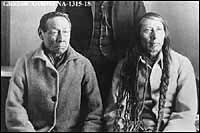Poundmaker, "Pitikwahanapiwiyin"
b. 1842 d. 1886
Poundmaker, "Pitikwahanapiwiyin", was Plains Cree in both culture and appearance and even though he was born into a prominent Plains Cree family from the House Band around 1842, his mother was of French Canadian descent. He had a typical childhood, learning the ways of the hunt and joining in on tribal wars when he was old enough, however his life took a dramatic turn when, in 1873, he encountered Crowfoot, head chief of the Blackfoot tribe. Even though the Cree and the Blackfoot were rival tribes, Crowfoot was immediately struck by the resemblance of Poundmaker to his dead son, who had been killed during a raid on a Cree camp. Crowfoot invited Poundmaker to stay with the Blackfoot at Blackfoot Crossing as his adopted son. Upon his return to his own Cree people, his influence with the chief of the Blackfoot tribe earned him great respect and status. In 1876 Poundmaker had become headman of one of the River People bands and was influential enough to speak at the Treaty No. 6 negotiations held at Fort Carlton, Manitoba. Much like his adoptive father, Crowfoot, Poundmaker was also a skilled diplomat and arbiter of peace. However, he did not share Crowfoot's optimism toward, or his trust in, governmental officials. He was very skeptical of governmental intentions and was therefore very critical of the treaty. Despite his concerns he agreed to sign the treaty, accepting a reserve along the Battle River.
 By 1880, Poundmaker was now a chief and had become very active in Indian politics. He represented the Cree at inter-band meetings, was a spokesperson with the government and even acted as a guide and interpreter for government officials on occasion. Despite all this life for his people on the reserve was difficult. From early on the government
had failed to fulfill their treaty promises. In 1883 they cut their rations to the native populations and delays in the delivery of supplies began to ignite fears amongst the native communities that the government was trying to starve them. When, in June 1884, a Thirst Dance was held on the Poundmaker reserve to discuss the worsening situation of the Indians, nearly 2000 people showed up making the North-West Mounted Police very nervous. Peace was maintained only through the efforts of Poundmaker and his fellow Cree Chief, Big Bear ("Mistahimaskwa").
By 1880, Poundmaker was now a chief and had become very active in Indian politics. He represented the Cree at inter-band meetings, was a spokesperson with the government and even acted as a guide and interpreter for government officials on occasion. Despite all this life for his people on the reserve was difficult. From early on the government
had failed to fulfill their treaty promises. In 1883 they cut their rations to the native populations and delays in the delivery of supplies began to ignite fears amongst the native communities that the government was trying to starve them. When, in June 1884, a Thirst Dance was held on the Poundmaker reserve to discuss the worsening situation of the Indians, nearly 2000 people showed up making the North-West Mounted Police very nervous. Peace was maintained only through the efforts of Poundmaker and his fellow Cree Chief, Big Bear ("Mistahimaskwa").  Tensions, however, remained high. The Métis success at Duck Lake had instilled great fears within the government agents. When Poundmaker attempted to negotiate for supplies in March 1885 with one of the Indian agents, negotiations failed and Cree and Stoneys began looting homes in the Battleford area. Despite Poundmaker's attempts to quell such disturbances tensions were running too high, and the Cree were inspired by the victories of the Métis. These tensions came to a head at Cutknife Hill in May 1885 when government officials attacked Poundmaker's camp, initiating a seven hour battle. Five days later the Métis were defeated by the government at Batoche and Poundmaker was imprisoned, despite his
continued efforts to prevent the bloodshed. He was sentenced to three years imprisonment but actually served only one year, being released early due to poor health. Four months later, while visiting his adoptive father Crowfoot on the Blackfoot reserve, he suffered a severe lung haemorrhage and died.
Tensions, however, remained high. The Métis success at Duck Lake had instilled great fears within the government agents. When Poundmaker attempted to negotiate for supplies in March 1885 with one of the Indian agents, negotiations failed and Cree and Stoneys began looting homes in the Battleford area. Despite Poundmaker's attempts to quell such disturbances tensions were running too high, and the Cree were inspired by the victories of the Métis. These tensions came to a head at Cutknife Hill in May 1885 when government officials attacked Poundmaker's camp, initiating a seven hour battle. Five days later the Métis were defeated by the government at Batoche and Poundmaker was imprisoned, despite his
continued efforts to prevent the bloodshed. He was sentenced to three years imprisonment but actually served only one year, being released early due to poor health. Four months later, while visiting his adoptive father Crowfoot on the Blackfoot reserve, he suffered a severe lung haemorrhage and died.
Listen to the Heritage Trails:
To listen to the Heritage Trails, you need the RealPlayer, available free from RealNetworks:
27 - Poundmaker Residential School
Summary:The alcohol and drug treatment centre in St. Albert was a residential school from the 1880s to the 1960s.
or Read the transcript:
27 - Poundmaker Residential School
Summary:The alcohol and drug treatment centre in St. Albert was a residential school from the 1880s to the 1960s.
[previous] [next] [back to top]







